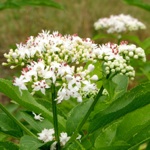Sambucus ebulus
Dwarf elder Σαμπούκος, βούζια.

Caprifoliaceae*- honeysuckle family Dicot.
Sambucus ebulus
Dwarf elder Σαμπούκος, βούζια.

Caprifoliaceae*- honeysuckle family Dicot.

Dwarf elder, Sambucus ebulus, is vigorous perennial weed with attractive divided leaves and small, creamy, white flowers with purple stamens; which are arranged in flat topped clusters above the foliage. The flowers are followed by bunches of deep purple, almost black, juicy berries on stalks which turn red.
The berries if eaten raw can cause stomach upset but the plant has been valued for its medicinal properties for many centuries. Its seeds have been found in small quantities in early prehistoric villages,1 suggesting that it was used as herbal medicine rather than for sustenance; recent scientific analysis confirms it as a rich source of pharmacologically active substances. 2
The plant is widespread throughout Eurasia; it is native to the Greek mainland and has now become naturalised on many islands, including Skopelos, where it grows in fallow fields and on field margins close to the town.
1.Catherine Perlès. The Early Neolithic in Greece: The First Farming Communities in Europe. Cambridge World Archaeology. 2001.
2.Marzie Jabbari. Biological Effects and Clinical Applications of Dwarf Elder (Sambucus ebulus L): A Review.Journal of Evidence-based Complementary & Alternative Medicine. 2017.

sambucus after sambuca (σαμβύκη) - an ancient greek musical instrument possibly made from the wood of elder tree ( S. nigra)
Ebulis from Eboulis (Ευβουλοσ) an ancient name (ευ) ,meaning good + βοθλοσ meaning council
i.e. good council because of the positive medicinal effects
* some authorities place S. ebulus in Adoxaceae family
